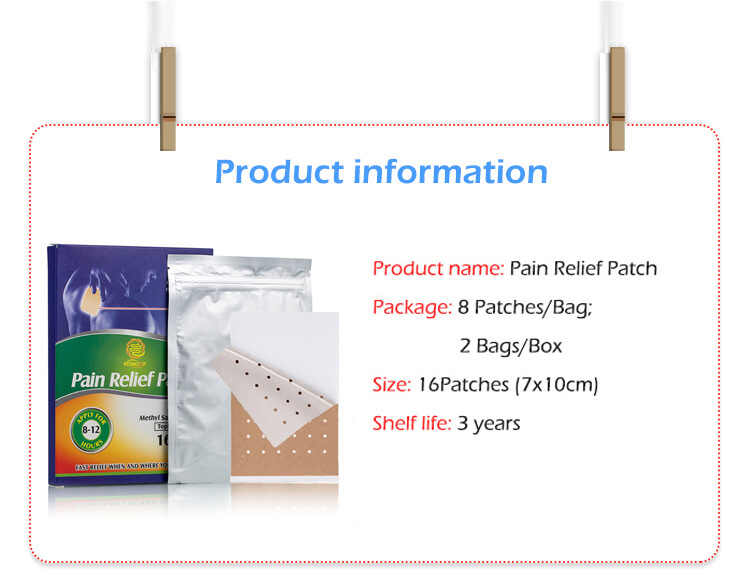Are Chronic Pain Patches Considered Drugs or Medical Devices? A Complete Guide for Brands and Suppliers
In the growing market of non-invasive pain management, Chronic Pain Patches are gaining immense popularity for their convenience, effectiveness, and rapid relief. However, a common and critical question arises: Are Chronic Pain Patches considered drugs or medical devices? This question is particularly important for anyone involved in manufacturing, branding, or selling these products—especially Chronic Pain Patches Manufacturers, OEM suppliers, or businesses exploring Private Label Chronic Pain Patches.
In this comprehensive guide, we will:
Clarify the regulatory classification of Chronic Pain Patches.
Explain how the U.S. FDA and international authorities determine whether a product is a drug or a medical device.
Explore implications for product development, compliance, and marketing.
Highlight how Custom Chronic Pain Patches can fit within either category, depending on their formulation and function.
Help you navigate the manufacturing process with the right Chronic Pain Patches Supplier or OEM partner.

Understanding the FDA’s Classification: Drug vs. Medical Device
The U.S. Food and Drug Administration (FDA) is the governing body that classifies health-related products. The classification of Chronic Pain Patches depends on the product's primary mode of action—that is, how it achieves its intended effect.
1. When Chronic Pain Patches Are Classified as Drugs
A patch is considered a drug if it delivers active pharmaceutical ingredients (APIs) that have a systemic or local pharmacological effect. For example:
Lidocaine Patches: Provide numbing through local anesthetic action.
Capsaicin or Menthol Patches: Deliver chemical agents that affect pain receptors.
Such products are governed under the FDA OTC Drug Monograph System or require New Drug Applications (NDAs), depending on their ingredients and claims.
Key compliance elements for drug-classified patches:
FDA-registered manufacturing facility
Drug Facts labeling
Batch testing for active ingredients
Adherence to Good Manufacturing Practices (GMP)
If you’re sourcing Custom Chronic Pain Patches or Private Label Chronic Pain Patches with active ingredients, your Chronic Pain Patches OEM must meet these regulatory standards.
2. When Chronic Pain Patches Are Considered Medical Devices
If a pain patch provides relief without using pharmacologically active ingredients, it may be classified as a medical device. These include:
Patches that work via thermal therapy (heat or cold).
Transdermal patches that use physical methods like TENS (transcutaneous electrical nerve stimulation).
Patches containing herbal or inert ingredients that serve a mechanical or barrier function.
For medical device classification, the product must meet FDA medical device regulations, including:
Device listing
Premarket notification (510(k)) if required
Biocompatibility testing
ISO 13485 or FDA QSR compliance
Many Chronic Pain Patches Suppliers specialize in either drug or device classifications, so identifying the correct partner is essential during product development.
International Perspective: CE Marking and Global Compliance
In the European Union, products are classified under the Medical Device Regulation (MDR) or EU Medicines Directive, similar to the FDA but with different procedural frameworks. For example:
A patch with no active pharmaceutical ingredient may qualify as a Class I or IIa medical device.
A patch with an API would be regulated as a medicinal product.
If you're manufacturing or sourcing from a Chronic Pain Patches OEM with international ambitions, ensure that they understand CE, ISO, and other regional compliance requirements.
Practical Implications for Chronic Pain Patches Manufacturers and Brands
1. Product Claims Drive Classification
The way a product is marketed and labeled plays a vital role in its classification. For example:
Claiming “temporarily relieves mild arthritis pain” is likely permissible under an OTC monograph (drug).
Claiming “stimulates healing through infrared therapy” may fall under a medical device category.
If you’re launching Private Label Chronic Pain Patches, ensure that your claims align with the regulatory pathway.
2. OEM Selection Based on Product Type
Choose a Chronic Pain Patches Manufacturer or OEM that specializes in the correct category:
Drug-focused OEMs will offer compliance with pharmacological standards, including ingredient validation and FDA audits.
Medical device OEMs focus on design safety, efficacy without APIs, and device certification.
3. Custom Formulations: A Double-Edged Sword
While Custom Chronic Pain Patches offer branding advantages, they also introduce regulatory complexity. A custom patch with lidocaine, for example, needs drug compliance. A patch using herbal extract for mild warming may not.
Discuss your formulation goals clearly with your Chronic Pain Patches Supplier to determine the correct classification and development plan.
How Private Label Chronic Pain Patches Fit Into the Picture
Private Label Chronic Pain Patches are pre-formulated and manufactured by a supplier, allowing you to market them under your own brand. Depending on the formula and packaging claims, these patches will follow either the drug or device pathway.
Key benefits of private labeling:
Faster market entry
Lower upfront investment
Existing compliance infrastructure
Option to rebrand proven products
However, you are still legally responsible for ensuring compliance, so your supplier or OEM must provide complete documentation.
Navigating Compliance with the Right Chronic Pain Patches Supplier
A reliable Chronic Pain Patches Supplier should provide:
Detailed classification guidance
Certificates of analysis (COAs)
FDA registration (for drug patches)
ISO 13485 or CE marking (for devices)
Transparent communication regarding labeling and legal claims
Whether you’re developing Custom Chronic Pain Patches or launching a Private Label product, working with an experienced OEM or manufacturer significantly reduces risk.
Conclusion: Drug or Device? It Depends on the Formulation and Function
So, are Chronic Pain Patches considered drugs or medical devices? The answer lies in their formulation and how they achieve pain relief.
If the patch uses active pharmaceutical ingredients, it’s classified as a drug.
If the patch functions without active ingredients and instead relies on physical or mechanical action, it’s a medical device.
Understanding this distinction is crucial for compliance, product development, marketing, and ultimately, the success of your brand. By partnering with the right Chronic Pain Patches OEM, Manufacturer, or Supplier, you can ensure regulatory clarity and confidence as you bring your product to market.
Related Questions and Short Answers
Q1: How can I tell if my Chronic Pain Patch is a drug or a medical device?
A: It depends on the ingredients and how the patch works. If it uses active ingredients like lidocaine or menthol, it’s likely a drug. If it works through heat, cold, or barrier action, it may be a medical device.
Q2: Do Private Label Chronic Pain Patches require FDA approval?
A: Not necessarily. If the patch complies with an existing OTC drug monograph or medical device exemption, separate FDA approval may not be required, but compliance and registration are.
Q3: What documentation should a Chronic Pain Patches Manufacturer provide?
A: COAs, GMP certification, labeling compliance, ingredient list, and for medical devices, FDA device registration or CE marking documents.
Q4: Can I sell Custom Chronic Pain Patches without a drug license?
A: If the patches are classified as drugs, you may need appropriate licensing depending on your location. For devices, the requirements are different. Consult your OEM for guidance.
Q5: Is it possible to reclassify a patch from a drug to a medical device?
A: No. Classification depends on the intended use and formulation. Altering ingredients to remove APIs could allow device classification, but it would be considered a new product.
Q6: Can a Chronic Pain Patches Supplier handle both drug and device categories?
A: Some suppliers are certified for both, but most specialize. Be sure to ask about their regulatory capabilities before committing.






